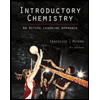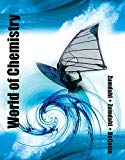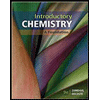
Mastering Chemistry with Pearson eText -- Standalone Access Card -- for Introductory Chemistry (6th Edition)
6th Edition
ISBN: 9780134565927
Author: Nivaldo J. Tro
Publisher: PEARSON
expand_more
expand_more
format_list_bulleted
Concept explainers
Textbook Question
Chapter 4, Problem 58E
Which elements are alkaline earth metal?
a. rubidium
b. tungsten
c. magnesium
d. cesium
e. beryllium
Expert Solution & Answer
Want to see the full answer?
Check out a sample textbook solution
Students have asked these similar questions
The two equations are forms of the Davies equation, used in thermodynamics for
activity coefficients:
ال
log Y₁ = -Az²
- 0,31
log
= Az²
- 0,31
1 + √Ĩ
1 + √√
k
These equations are consistent and imply that
Yi
=
Is this last equation correct?
k
The two equations are forms of the Davies equation, used in thermodynamics for
activity coefficients:
ال
log Y₁ = -Az²
- 0,31
log
= Az²
- 0,31
1 + √Ĩ
1 + √√
k
These equations are consistent and imply that
Yi
=
Is this last equation correct?
k
For the Davies equation, both expressions are correct:
log Y₁ = -Az²
√i
- 0,31
1 +
√
k
log-
= Az
- 0,31
k
1 + √Ĩ
Chapter 4 Solutions
Mastering Chemistry with Pearson eText -- Standalone Access Card -- for Introductory Chemistry (6th Edition)
Ch. 4 - Q1. Which statement is not part of Dalton’s...Ch. 4 - Q2. Which statement best summarizes the nuclear...Ch. 4 - Q3. An ion composed of which of these particles...Ch. 4 - Which element is a maingroup metal with an even...Ch. 4 - Which element is a halo0gen? a. Ne b. O c. Ca d. ICh. 4 - Prob. 6SAQCh. 4 - Q7. Which element is a row 4 noble gas?
a. Ne
b....Ch. 4 - How many element does the predictable (most...Ch. 4 - Q9. How many neutrons does the Fe-56 isotope...Ch. 4 - Q10. Determine the number of protons, neutrons,...
Ch. 4 - Q11. What is the charge of the Cr ion that...Ch. 4 - An element has four naturally occurring isotopes;...Ch. 4 - What did Democritus contribute to our modern...Ch. 4 - 2. What are three man ideas in Dalton’s atomic...Ch. 4 - Describe Rutherfords gold foil experiment and the...Ch. 4 - What are the main ideas in the nuclear theory of...Ch. 4 - List the three subatomic particles and their...Ch. 4 - What is electrical charge?Ch. 4 - Is matter usually charge-neutral? How would be...Ch. 4 - 8. What does the atomic number of an element...Ch. 4 - What is a chemical symbol?Ch. 4 - Prob. 10ECh. 4 - What Dmitri Mendeleevs main contribution to our...Ch. 4 - What is the man idea in the periodic law?Ch. 4 - How is the periodic table organized?Ch. 4 - Prob. 14ECh. 4 - Prob. 15ECh. 4 - Prob. 16ECh. 4 - What is a family or group of elements?Ch. 4 - Locate each group of elements on the periodic...Ch. 4 - 19. What is an ion?
Ch. 4 - Prob. 20ECh. 4 - 21. Locate each group on the periodic table and...Ch. 4 - 22. What are isotopes?
Ch. 4 - Prob. 23ECh. 4 - Prob. 24ECh. 4 - What notations are commonly used to specify...Ch. 4 - What is the atomic mass of an element?Ch. 4 - 27. Which statement are inconsistent with Dalton’s...Ch. 4 - Which statements are consistent with Daltons...Ch. 4 - Which statements are inconsistent with Rutherfords...Ch. 4 - 30. Which statement are consistent with...Ch. 4 - Prob. 31ECh. 4 - 32. Rutherford’s experiment indicated that matter...Ch. 4 - 33. Which statement about electrons is true?
a....Ch. 4 - 34. Which statement about electrons is false?
a....Ch. 4 - 35. Which statement about protons is true?
a....Ch. 4 - 36. Which statement about protons is false?
a....Ch. 4 - 37. How many electrons would it take to equal the...Ch. 4 - A helium nucleus has two has two neutrons. How...Ch. 4 - What mass of electrons is required to neutralize...Ch. 4 - 40. What mass of protons is required to neutralize...Ch. 4 - Find the atomic number (Z) for each element. a. Fr...Ch. 4 - Prob. 42ECh. 4 - 43. How many protons are in the nucleus of an atom...Ch. 4 - How many protons are in the nucleus of an atom of...Ch. 4 - 45. List the symbol and atomic number of each...Ch. 4 - 46. List the symbol and atomic number of each...Ch. 4 - List the name and the atomic number of each...Ch. 4 - List the name and the atomic number of each...Ch. 4 - Fill in the blanks to complete the table. Element...Ch. 4 - Fill in the blanks to complete the table. Element...Ch. 4 - Classify each element as a metal, nonmetal, or...Ch. 4 - Classify each element as a metal, nonmetal, or...Ch. 4 - Which elements would you expect to lose electrons...Ch. 4 - 54. Which elements would you expect to gain...Ch. 4 - 55. Which elements are main group elements?
a....Ch. 4 - Which elements are not main-group elements? a. AI...Ch. 4 - 57. Which elements are alkaline earth metals?
a....Ch. 4 - Which elements are alkaline earth metal? a....Ch. 4 - 59. Which elements are alkali metals?
a. barium
b....Ch. 4 - Which elements are alkali metals? a. scandium b....Ch. 4 - Classify each element as a halogen, a noble gas,...Ch. 4 - Prob. 62ECh. 4 - 63. To what group number does each element...Ch. 4 - Prob. 64ECh. 4 - Which element do you expect to be most like...Ch. 4 - Which element do you expect to be most like...Ch. 4 - Which pair of elements do you expect to be most...Ch. 4 - Prob. 68ECh. 4 - 69. Which element is a main – group nonmetal?
a....Ch. 4 - Prob. 70ECh. 4 - Prob. 71ECh. 4 - Prob. 72ECh. 4 - Prob. 73ECh. 4 - Prob. 74ECh. 4 - Determine the change of each ion. a. oxygen ion...Ch. 4 - 76. Determine the charge of each ion.
a. tungsten...Ch. 4 - Determine the number of protons and electrons in...Ch. 4 - 78. Determine the number of protons and electrons...Ch. 4 - Prob. 79ECh. 4 - Determine whether each statement is true or false....Ch. 4 - Predict the ion formed by each element. a. Rb b. K...Ch. 4 - 82. Predict ion formed by each element.
a. F
b....Ch. 4 - Predict how many electrons each element will most...Ch. 4 - Predict how many electrons each element will most...Ch. 4 - 85. Fill in the blanks to compele the...Ch. 4 - Fill in the blacks to complete the table. Symbol...Ch. 4 - 87. Determine the atomic number and mass number...Ch. 4 - 88. How many neutrons are in an atom each atomic...Ch. 4 - 89. Write isotopic symbols in the form for each...Ch. 4 - Write isotopic symbol in the form X-A (for...Ch. 4 - Write the symbol for each isotope in the form XZA....Ch. 4 - Write the symbol for each isotope in the form XZA....Ch. 4 - 93. Determine the number of protons and neutrons...Ch. 4 - Determine the number of protons and neutrons in...Ch. 4 - Carbon 14, present within living organisms and...Ch. 4 - Plutonium-239 is used in nuclear bombs. Determine...Ch. 4 - Rubidium has two naturally occurring isotopes:...Ch. 4 - 98. Silicon has three naturally occurring...Ch. 4 - Bromine has two naturally occurring isotopes...Ch. 4 - Silver has two naturally occurring isotopes...Ch. 4 - 101. An element has two naturally occurring...Ch. 4 - Copper has two naturally occurring isotopes. Cu-63...Ch. 4 - Electrical charge is sometimes reported in...Ch. 4 - 104. How many excess protons are in a charged...Ch. 4 - 105. The hydrogen atom contains 1 proton 1...Ch. 4 - 106. Carbon-12 contains 6 protons and 6 neutrons....Ch. 4 - Prepare a table like Table 4.2 for the four...Ch. 4 - 108. Determine the number of protons and neutrons...Ch. 4 - Fill in the blanks to complete the table. Symbol Z...Ch. 4 - 110. Fill in the blanks to complete the...Ch. 4 - Europium has two naturally occurring isotopes:...Ch. 4 - Rhenium has two naturally occurring isotopes:...Ch. 4 - Chapter 1 describes the difference between...Ch. 4 - 114. Chapter1 describes the difference between...Ch. 4 - The atomic mass of fluorine is 19. 00 amu, and all...Ch. 4 - 116. The atomic mass of germanium is 72.61 amu. Is...Ch. 4 - Prob. 117ECh. 4 - Gallium has only two naturally occurring isotopes,...Ch. 4 - 119. The figure shown here is a representation of...Ch. 4 - 120. Neutron stars are believed to be composed of...Ch. 4 - 121. Complete the following...Ch. 4 - Prob. 122QGWCh. 4 - Prob. 123QGWCh. 4 - Prob. 124QGWCh. 4 - 125. The graph at the right shows the atomic...
Knowledge Booster
Learn more about
Need a deep-dive on the concept behind this application? Look no further. Learn more about this topic, chemistry and related others by exploring similar questions and additional content below.Similar questions
- k In Davies' equation log y₁ = log- log y₁ = log | = -Az² + ✓// k A is a constant that always equals 1.02. Correct? - 0,31arrow_forwardIndicate whether the equality is true Yi How is it obtained? k%arrow_forwardIndicate the relationship between the activity coefficient YA and the rate constant of a bimolecular reaction in solution k and the rate constant at infinite dilution ko.arrow_forward
- Describe the saline effect that occurs in solutions.arrow_forwardBriefly explain what the infinite dilution rate constant (k∞) consists of.arrow_forwardThe Davies equation corrects the Debye-Hückel limiting law for calculating the activity coefficient of an electrolyte in solution at relatively high concentrations. Mathematically, it is expressed as: log y₁ = -Az²? 1 + √Ĩ - 0,31) Is the formula correct?arrow_forward
- Differentiate between the concepts of "ionic salt effect" and "kinetic salt effect."arrow_forwardDifferentiate the concepts of “salino effect” and “salino kinetic effect”.arrow_forwardCome and compare the Bronsted-Bjerrum calculation, the Debye and Hückel calculation, and the Davies calculation.arrow_forward
- plz watch the youtube video (the title of this topic) by roxi H. she explains it step by step but i get the wrong answerarrow_forwardWriting the rate law implied by a simple mechanism To exit full screen, press and hold esc Suppose the decomposition of ozone proceeds by the following mechanism: step elementary reaction rate constant 1 →>> O3(9) O2(g) + O(g) k₁ 2 03(g) + O(g) → 202(g) k2 Suppose also k₁ »k2. That is, the first step is much faster than the second. Write the balanced chemical equation for the overall chemical reaction: Write the experimentally- observable rate law for the overall chemical reaction. ☐ rate = ☐ Note: your answer should not contain the concentrations of any intermediates. Express the rate constant k for the overall chemical reaction in terms of K1, K2, and (if necessary) the rate constants k-1 and K-2 for the reverse of the two elementary reactions in the mechanism. k = ☐ 000 18 ローロ Ar OOarrow_forwardDeducing a rate law from the change in concentration over time To exit full screen, press and hold esc A chemistry graduate student is studying the rate of this reaction: H2CO3(aq) → H₂O(aq) +CO₂ (aq) - She fills a reaction vessel with H2CO3 and measures its concentration as the reaction proceeds: time (milliseconds) [H2CO3] 0 0.0500 M 10. 0.0266M 20. 0.0181 M 30. 0.0138M 40. 0.0111 M Use this data to answer the following questions. Write the rate law for this reaction. Calculate the value of the rate constant k. Round your answer to 2 significant digits. Also be sure your answer has the correct unit symbol. rate ☐ x10 k = Х 000 18 Ararrow_forward
arrow_back_ios
SEE MORE QUESTIONS
arrow_forward_ios
Recommended textbooks for you
 Introductory Chemistry: An Active Learning Approa...ChemistryISBN:9781305079250Author:Mark S. Cracolice, Ed PetersPublisher:Cengage Learning
Introductory Chemistry: An Active Learning Approa...ChemistryISBN:9781305079250Author:Mark S. Cracolice, Ed PetersPublisher:Cengage Learning World of Chemistry, 3rd editionChemistryISBN:9781133109655Author:Steven S. Zumdahl, Susan L. Zumdahl, Donald J. DeCostePublisher:Brooks / Cole / Cengage LearningChemistry: Matter and ChangeChemistryISBN:9780078746376Author:Dinah Zike, Laurel Dingrando, Nicholas Hainen, Cheryl WistromPublisher:Glencoe/McGraw-Hill School Pub Co
World of Chemistry, 3rd editionChemistryISBN:9781133109655Author:Steven S. Zumdahl, Susan L. Zumdahl, Donald J. DeCostePublisher:Brooks / Cole / Cengage LearningChemistry: Matter and ChangeChemistryISBN:9780078746376Author:Dinah Zike, Laurel Dingrando, Nicholas Hainen, Cheryl WistromPublisher:Glencoe/McGraw-Hill School Pub Co
 Introductory Chemistry: A FoundationChemistryISBN:9781337399425Author:Steven S. Zumdahl, Donald J. DeCostePublisher:Cengage Learning
Introductory Chemistry: A FoundationChemistryISBN:9781337399425Author:Steven S. Zumdahl, Donald J. DeCostePublisher:Cengage Learning Living By Chemistry: First Edition TextbookChemistryISBN:9781559539418Author:Angelica StacyPublisher:MAC HIGHER
Living By Chemistry: First Edition TextbookChemistryISBN:9781559539418Author:Angelica StacyPublisher:MAC HIGHER

Introductory Chemistry: An Active Learning Approa...
Chemistry
ISBN:9781305079250
Author:Mark S. Cracolice, Ed Peters
Publisher:Cengage Learning

World of Chemistry, 3rd edition
Chemistry
ISBN:9781133109655
Author:Steven S. Zumdahl, Susan L. Zumdahl, Donald J. DeCoste
Publisher:Brooks / Cole / Cengage Learning

Chemistry: Matter and Change
Chemistry
ISBN:9780078746376
Author:Dinah Zike, Laurel Dingrando, Nicholas Hainen, Cheryl Wistrom
Publisher:Glencoe/McGraw-Hill School Pub Co


Introductory Chemistry: A Foundation
Chemistry
ISBN:9781337399425
Author:Steven S. Zumdahl, Donald J. DeCoste
Publisher:Cengage Learning

Living By Chemistry: First Edition Textbook
Chemistry
ISBN:9781559539418
Author:Angelica Stacy
Publisher:MAC HIGHER
The Bohr Model of the atom and Atomic Emission Spectra: Atomic Structure tutorial | Crash Chemistry; Author: Crash Chemistry Academy;https://www.youtube.com/watch?v=apuWi_Fbtys;License: Standard YouTube License, CC-BY